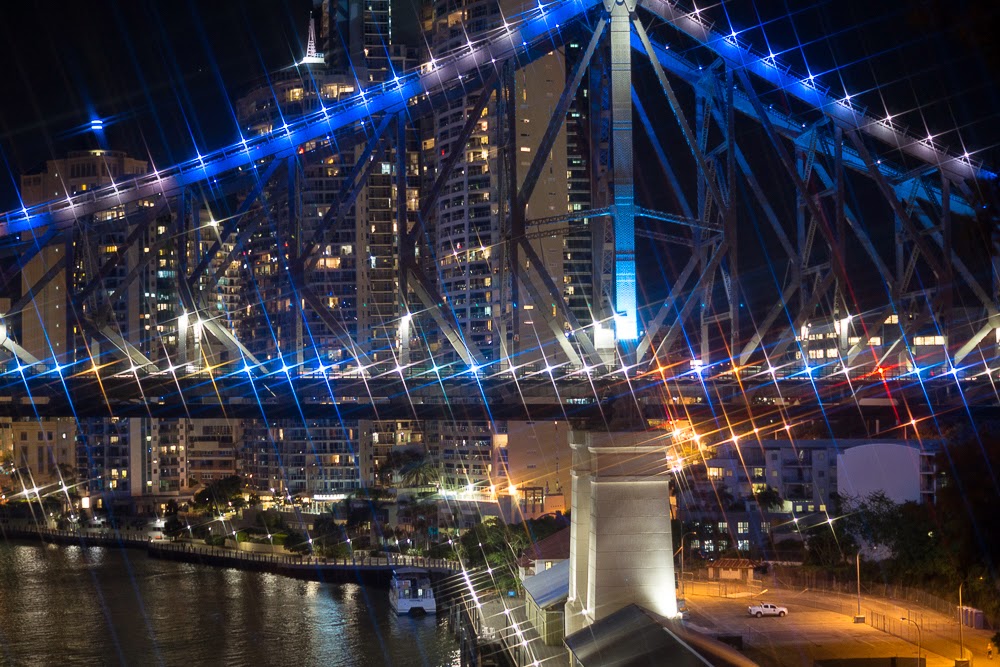I thought I would put triggertrap onto my Samsung 'Galaxy' tablet as it has far more life in it than my phone which has a faulty battery. I had to do a double-take as the app looks completely different and has different features. After checking that everything connected okay and was in working order I set off to capture the October Blood Moon from Mt Coot-tha. The photographers ephemeris indicated that the moon would rise above Brisbane botanical gardens and traverse the city so I was pretty excited. I wanted to be sure to get a good position and I knew that there would be photographers and astronomers by the score for such an event so I left early.
Sadly while in transit to claim my spot the weather closed in unexpectedly and although hopeful that the thick cloud cover would dissipate in time for the eclipse, it was not to be. However, I was not going to let that stop me from taking some photos and attempting another bramping. Cloud cover was very thick and verging on fog with the city in the distance difficult to see at times, so it would be good practice for me. About 150 shots gave me the following (same settings as the following clip - just cut short)
Trying to anticipate the lighting transition is for me the most difficult thing but I know that one must experiment and try different things in order to find the optimum settings. Using the Sony a99 with the G2 SSM 70-400 lens in Manual mode at ISO 100, 160mm, f/11, Bulb. Triggertrap was set at 365 images over 60 minutes with the first exposure at 1/15sec and the last exposure at 8sec. This is a photo every 10 seconds.
In my last blog I mentioned setting the drive mode to multi, I'll explain why. I have found setting my drive mode to multiple exposures allows the camera to process overlap, whereas single exposures as a rule of thumb require as much time to process as the exposure duration. I.e. a 10 second exposure requires 10 seconds of processing time and the shutter will not fire until this process is complete. This means bramping up to 8 seconds would require a minimum of 16 seconds as the interval add a couple more to be on the safe side and you are looking at 18 seconds. This interval would effectively halve the number of exposures and of course it would (in my opinion) be less than satisfactory time-lapse.
Earlier this week I decided to head into the city and try a few other settings so I went up to Wilson's Lookout for this bramping. Again I used the Sony a99 but changed the lens to the DT 18-250mm. I wanted to try a smaller ISO and aperture so setup ISO 50, 20mm, f/22, Bulb and set Triggertrap on my phone (Samsung Galaxy III) at 360 shots over 1 hour starting at 1/15sec (the fastest shutter speed by triggertrap bramping) and ending at 8.0sec. Not good, it took a lot of work in post to get anything anywhere near usable. BTW I always shoot in RAW when trying something a little different, just in case I need to recover data in post (Post processing I use Lightroom 5.4 and Gunther Wegner's LRTimelapse 3.4) I'm still learning both of these applications but having a ball.
While I was in the city I thought I would try and capture a short time lapse of the Story Bridge with it's traffic from one end and because I'm not as fit as I used to be, it was going to be the closest end. Now I wanted to capture increasing light trails as the time lapse went on, I had done this on the M1 and the result was fantastic but I had been bramping and I thought why not try that here so I located a sweet spot where I could get the bridge in frame and I was almost central as I looked down the length of the bridge. I used the same equipment and light limiting settings as the previous time-lapse however instead of setting the camera to bulb I set the camera's shutter speed to 1/10sec. This of course overrides the Triggertrap shutter settings. I used my Tablet as the phone was almost out of battery. In the process of getting setup I took a few images, one of which I'll share now.
The biggest issue is the fastest shutter speed allowed by Triggertrap's bramping app is only 1/15sec and there is no facility to alter the ISO settings which would really be something. Imagine ISO 100 and 1/250 sec or ISO 800 and 1/10sec either would freeze the traffic's lights and then we could increase gradually to say 8sec to give us the longer light trails ... but for now this is the result.
I went back to Wilson's Outlook last night to see if I could improve on on the previous Time-lapse and I am very pleased with the result. I used the Sony a99 with the DT 18-250mm lens. I wanted to
try a larger ISO and aperture so setup ISO 100, 20mm, f/22, Bulb and
set Triggertrap on the Samsung Galaxy Tab at 360 shots over 1
hour starting at 1/15sec and ending at 7.0sec.
Before I packed up to head home I thought I would have a little fun with the DT 1.8/50 Lens and a Star filter.
What do you think? Please leave comment's.
Till next time, take care and stay safe.




No comments:
Post a Comment